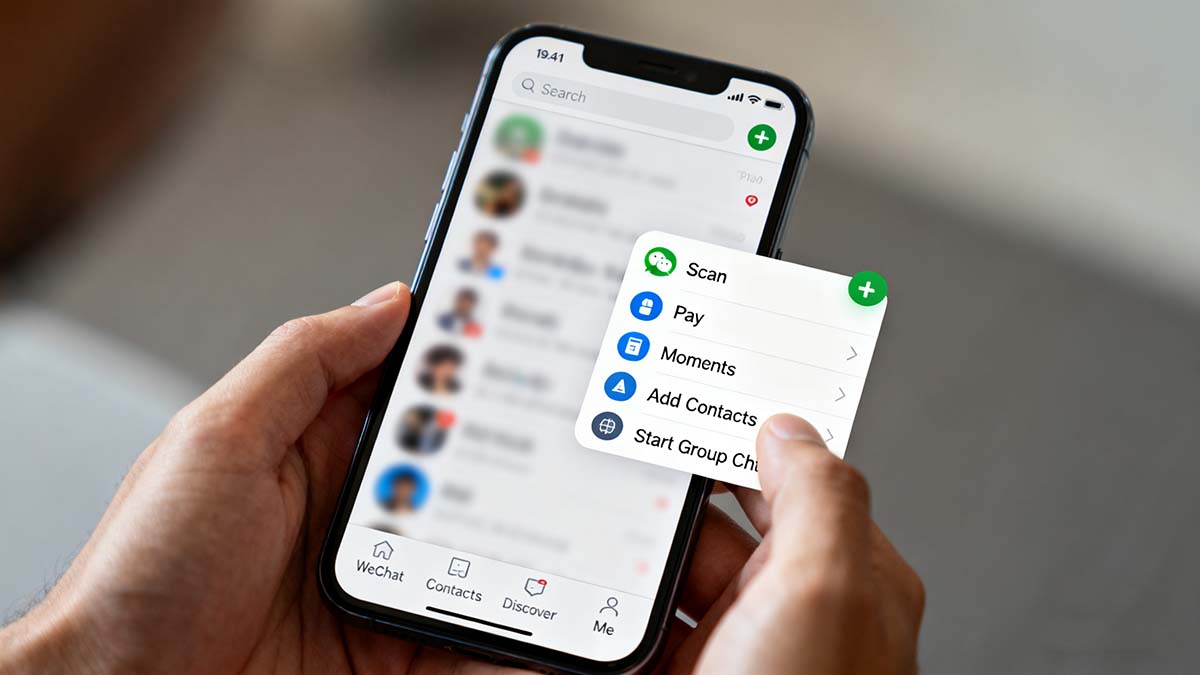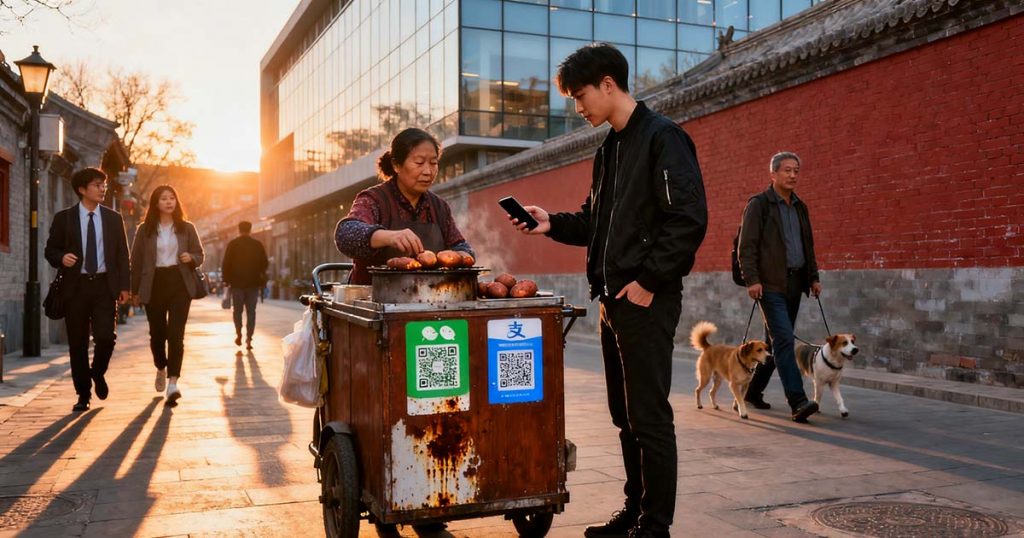Picture this: You’re standing at a Beijing street food stall, mouth watering at the sight of perfectly grilled lamb skewers, when the vendor points to a QR code and says something in Mandarin you don’t understand, you don’t know how to pay in china. Meanwhile, the local next to you simply waves their phone and walks away with their food. Welcome to China’s cashless revolution – and yes, as a foreign tourist, you’re probably going to feel like you’ve time-traveled to the future.
Here’s the reality nobody tells you in those glossy travel guides: paying for things in China as a foreigner in 2024 is both easier and more complicated than you think. Let me break down exactly what works, what doesn’t, and how to avoid those awkward moments when you’re holding cash that nobody wants.
How to Pay in China: The Current Payment Landscape
China operates in what I call “post-cash reality.” While the West gradually adopted contactless payments, China leapfrogged directly from cash to mobile payments. We’re talking about a country where even street beggars have QR codes.
The numbers speak for themselves:
- 86% of Chinese consumers use mobile payments as their primary method
- Over 900 million active users on WeChat Pay and Alipay combined
- Many vendors literally cannot make change for cash transactions
But here’s where it gets interesting for foreign visitors: this digital payment dominance created a two-tier system that most travel websites don’t adequately explain.
WeChat Pay for Tourists: What Actually Works
The Good News: WeChat Pay now accepts international cards – sort of.

Setting Up WeChat Pay as a Tourist: You can link your international Visa or Mastercard directly through the WeChat app, but there are catches:
- Transaction limits: Usually capped at 200-500 RMB per transaction
- Daily limits: Often around 2,000 RMB per day
- Merchant acceptance: Not all vendors accept international card-linked WeChat Pay
- Processing delays: Some transactions take 1-3 business days to appear on your card
Real-world experience: WeChat Pay with international cards works reliably at chain restaurants, major retailers, and tourist-focused businesses. Street vendors and small local shops? Hit or miss.
Pro tip: Load WeChat Pay with cash at convenience stores like 7-Eleven or FamilyMart. Many locations offer cash-to-WeChat credit services, though you’ll need basic Chinese communication skills or translation apps.
Alipay International: The Tourist-Friendly Option
Alipay has made the biggest push to accommodate international visitors, and it shows.
Tour Pass Feature: Alipay’s “Tour Pass” is specifically designed for tourists:
- Pre-load with international cards
- Works at most Alipay-accepting merchants
- Clear English interface
- No daily transaction headaches
Coverage: Almost everywhere.
The reality check: While Alipay International has broader acceptance than tourist-mode WeChat Pay, you’ll still encounter vendors who only accept domestic versions linked to Chinese bank accounts.
Cash in China: Not Dead, But Definitely Endangered
Where Cash Still Rules:
- Temple donation boxes
- Emergency situations when digital systems fail
- Elderly vendors who haven’t adopted digital payments
Cash Challenges:
- ATMs can be scarce in tourist areas
- Large denomination bills (100 RMB) often rejected
- Counterfeit concerns make some vendors nervous about cash
Strategic Cash Usage: Keep 500-1000 RMB in mixed denominations (50s, 20s, 10s) for situations where digital fails. Don’t rely on cash as your primary payment method.
Credit Cards: Limited But Strategic
International credit cards work at:
- High-end hotels and restaurants
- International chain stores
- Major tourist attractions
- Airport and train station vendors
The catch: Acceptance is inconsistent even within the same chain. A McDonald’s in Shanghai might accept Visa, while the one two blocks away doesn’t.
Fees to consider:
- Foreign transaction fees (typically 2-3%)
- Dynamic currency conversion charges
- Cash advance fees for ATM usage
City-by-City Payment Reality
Beijing & Shanghai: Digital payment paradise for tourists. Most international-friendly payment options available.
Shenzhen: Tech capital means cutting-edge payment options, but also means merchants expect you to be digitally savvy.
Xi’an, Chengdu, Hangzhou: Major tourist cities with good digital infrastructure, but more cash backup needed.
Smaller cities/rural areas: Cash becomes more important. Some places still operate primarily on cash.
Transportation Payment Specifics
Metro Systems: All major Chinese cities now offer multiple payment options for subway travel:
- Mobile apps: City-specific metro apps support mobile payments (WeChat Pay, Alipay)
- Automatic ticket machines: Accept mobile payments and small denomination cash
- Staffed ticket counters: Accept both mobile payments and cash
- Tourist tip: Download the local metro app before arrival for the smoothest experience
Ride-hailing Services:
- Didi (China’s Uber): Fully supports mobile payments including tourist-friendly options
- Street taxis: Increasingly equipped with QR code payment systems
- Payment flexibility: Most drivers accept both mobile payments and cash
- Pro tip: Screenshot your destination in Chinese characters to show drivers
High-speed Train Travel:
- Mobile booking: 12306 app and third-party apps support mobile payments
- Station ticket counters: Accept both mobile payments and cash
- Ticket machines: Support mobile payments for same-day purchases
- Food and beverages: Onboard service accepts mobile payments; station vendors universally accept QR code payments
What to Prepare Before You Go
Essential Setup (Do This at Home):
- Download WeChat and Alipay apps
- Set up accounts with your international phone number
- Link your cards and test with small transactions
- Screenshot important phrases in Chinese
- Download offline translation apps
Backup Plan Essentials:
- Multiple international cards from different banks
- Small denomination cash (obtained in China)
- Backup payment app (if WeChat fails, try Alipay)
- Emergency contact for your bank (international calls)
Common Payment Situations and Solutions
Street Food Vendors: Try mobile payment first, have small cash bills ready as backup.
Convenience Stores: Usually the most flexible – accept multiple payment methods including international cards.
Restaurants: Chain restaurants typically accept international payments; local joints often require Chinese mobile payments or cash.
Shopping: Malls and department stores usually accommodate international cards; small boutiques prefer local digital payments.
Troubleshooting Payment Problems
When Digital Payments Fail:
- Check your internet connection
- Try switching between WiFi and mobile data
- Restart the payment app
- Have cash ready as immediate backup
Language Barriers:
- Learn “WeChat Pay” (微信支付) and “Alipay” (支付宝) pronunciations
- Use translation apps to communicate payment preferences
- Point to payment method icons on your phone
Card Declined Issues:
- Notify your bank of China travel plans
- Use cards with no foreign transaction fees
- Have backup cards from different networks (Visa and Mastercard)
The Bottom Line: Payment Strategy for China
Your payment hierarchy should be:
- Primary: Alipay International or WeChat Pay with international card
- Secondary: Cash in small denominations
- Emergency backup: International credit card
- Last resort: Find an ATM or money exchange
Budget planning: Expect to use digital payments for 85-90% of transactions, cash for 5-10%, and international cards for 5-10%.
The reality is that paying in China as a tourist requires more preparation than most countries, but once you have your systems set up, it’s incredibly convenient. The key is redundancy – never rely on just one payment method, especially in a country that’s constantly innovating its financial technology.
Advanced Payment Scenarios: What Experienced Travelers Know
Splitting Bills: Chinese mobile payments make bill splitting incredibly easy. Most restaurant tables have QR codes that let each person pay their portion directly. As a tourist, you might need friends to pay first and reimburse them, or stick to paying the full bill yourself.
Tipping Culture Clash: Here’s something that catches many Western visitors off-guard: tipping isn’t expected in China, and mobile payments don’t have built-in tip functions. This actually simplifies transactions but can feel strange if you’re used to tipping service workers.
Seasonal Payment Variations: During major holidays (Chinese New Year, Golden Week), payment systems can become overloaded. Having multiple backup methods becomes even more critical during peak travel times.
Regional Payment Preferences: While both WeChat Pay and Alipay work nationwide, you’ll notice regional preferences. Northern China tends to favor WeChat Pay slightly, while Alipay has stronger penetration in southern regions. Tourist areas typically accept both equally.
The Cultural Experience: Embracing Digital Payment Culture
QR Code Etiquette: Learning to scan QR codes efficiently isn’t just practical – it’s cultural integration. Chinese users can scan and pay in seconds. Take time to practice the process at less busy locations first.
Payment Speed Expectations: Chinese consumers expect transactions to complete within 2-3 seconds. Don’t be surprised if vendors show mild impatience if your international payment method takes longer to process.
The Social Aspect: Mobile payments in China aren’t just transactions – they’re social interactions. WeChat’s red envelope feature, for example, is deeply embedded in gift-giving culture. While you won’t need this as a tourist, understanding it helps appreciate why mobile payments became so integral to daily life.
Privacy Considerations: Chinese digital payments collect significantly more data than Western systems. As a tourist, be aware that your spending patterns, locations, and preferences may be tracked more extensively than you’re accustomed to.
Emergency Payment Protocols
When Everything Goes Wrong: Keep a “crisis payment kit”: 500 RMB cash in mixed denominations, screenshots of important payment app screens in both English and Chinese, and your bank’s international emergency contact number saved offline.
Hospital and Emergency Services: Medical facilities typically accept cash and may require deposits before treatment. International insurance coordination can be complex, so having multiple payment methods readily available is crucial.
Late-Night Payment Reality: 24-hour convenience stores are your salvation for late-night emergencies. They typically accept all payment methods and can help you add cash to mobile payment accounts.
Lost Phone Scenarios: Losing your phone in China is like losing your wallet, ID, and GPS simultaneously. Consider traveling with a backup device or ensuring someone in your group has backup payment methods.
Final insider tip: Always have your phone charged and carry a portable battery. In China, your phone isn’t just a communication device – it’s your wallet, translator, and navigation system all in one. Running out of battery in China feels more like losing your entire identity than anywhere else in the world.
Remember: China’s payment landscape evolves rapidly. What works in 2025 might change by 2026, so always check for the most current information before your trip. But with this foundation, you’ll navigate Chinese payments like a seasoned traveler, not a confused tourist waving cash at QR codes.
You may want to know when to visit china? china travel budget breakdown? complete china travel planning guide?

